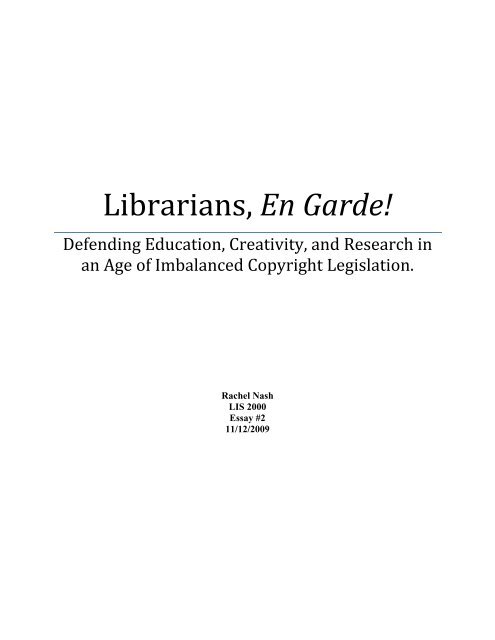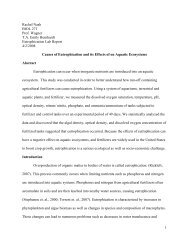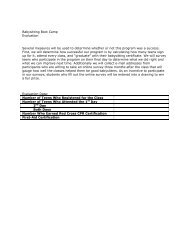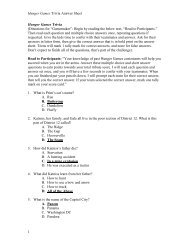Librarians, En Garde! - Rachel Nash's Librarian I Portfolio
Librarians, En Garde! - Rachel Nash's Librarian I Portfolio
Librarians, En Garde! - Rachel Nash's Librarian I Portfolio
You also want an ePaper? Increase the reach of your titles
YUMPU automatically turns print PDFs into web optimized ePapers that Google loves.
<strong><strong>Librarian</strong>s</strong>, <strong>En</strong> <strong>Garde</strong>!Defending Education, Creativity, and Research inan Age of Imbalanced Copyright Legislation.<strong>Rachel</strong> NashLIS 2000Essay #211/12/2009
Nash | 1Ever since the enactment of the first copyright legislation, librarians have dealt withcopyright issues every day. From the printing press to the Xerox machine, copyright laws haveco-evolved with new technologies, to provide equal benefits to both creators and users ofintellectual property, which has allowed libraries to continue to serve the information needs oftheir patrons. 1 The books Digital Copyright, Free Culture, Remix, and The Wealth of Networkssupport the notion that the internet and other digital technologies have once again caused achange in copyright laws. However, authors Jessica Litman, Lawrence Lessig, and YochaiBenkler join their voices with those many people around the world who believe that currentcopyright legislation has failed to maintain the balance of rights between the creators of creativeand intellectual works and their users. Copyright holders, especially major corporations such aspublishers, who are feeling threatened by the potential copyright infringements not evenimagined in the analog world, but made easily in the digital world, have managed to convincelawmakers to create copyright laws which severely limit the rights of the public to copyrightedworks. 2 This imbalance negatively affects the ability of library services to support the continuingprogression of education, creativity, and research.The traditional purpose of copyright law is to maintain the necessary fragile balance ofbenefits and rights between creators and users of intellectual property. Copyright allows creatorsto gain money and fame from their works, thereby providing incentives to continue creating anddistributing information. After a limited amount of time, intellectual property passes into thepublic domain, and inspires the next generation of users and creators to learn from and buildupon knowledge of the past. The first copyright law, the Statue of Anne, established this balance1 Kathy Sheat, "Libraries, Copyright and the Global Digital <strong>En</strong>vironment," The Electronic Library 22, no. 6 (2004),487-491, http://www.emeraldinsight.com/10.1108/02640470410570785 (accessed November 4, 2009): 487.2 Grant Painter, "The Publisher Over Your Shoulder," ALA: American Library Association, http://www.ala.org/ala/issuesadvocacy/copyright/copyrightarticle/publisherover.cfm (accessed November 3, 2009).
Nash | 2in order to define and protect the rights of both creators and users of intellectual property inequal proportions so that learning and creativity could progress. 3 It held that creators could notcontinue to create their works without incentives that allowed them to support themselves, butalso that the monopoly creators held for their works should only be in force for a limited time sothat the restrictions placed on users of these works did not inhibit future generations fromprogressing in the sciences and arts. The Statue of Anne came about as a direct result of theinvention of the printing press, a revolutionary new technology that made it possible to makecopies of the written word and distribute them as never before. The printing press introduced anew kind of economy where authors of the written word could hire printers to copy their worksand help distribute them for money. Yet if the public never gained the right to build oncopyrighted works, it could greatly slow or even stop the progression of knowledge. 4Thus, earlylawmakers built limitations and exceptions benefiting the public into copyright law. One suchlimitation created the public domain, and many exceptions allowed libraries to meet theinformation needs of their patrons in the analog world. 5Exceptions to copyright laws pertaining to the analog world have traditionally providedlibraries with the power to copy and distribute information in order to provide access to theirpatrons for the purposes of supporting and promoting education. In Free Culture Lessig writesthat in eighteenth century <strong>En</strong>gland, booksellers had a huge influence “over the spread ofknowledge,” 6 and that many saw the monopoly they held over information as harmful toeducation. Thus, Parliament limited the term of copyright in order to make sure one publisher3 Jessica Litman. Digital Copyright. (Amherst, NY: Prometheus Books, 2001), 15.4 Lawrence Lessig, Free Culture: The Nature and Future of Creativity (New York, NY: Penguin Group, 2004), 88-89.5 Library Copyright Alliance, International Federation of Library Associations and Electronic Information forLibraries, Copyright Limitations and Exceptions for Libraries. Library Copyright Alliance, http://www.arl.org/lca/bm~doc/4_lenov2008.pdf (accessed November 6, 2009).6 Lessig, Free Culture: The Nature and Future of Creativity, 89.
Nash | 3couldn’t retain the rights to important books, and impede the spread of information to the generalpopulace. 7 The creation of the public domain increased the importance of library services in thatit allowed libraries to create copies of works in the public domain, which in turn ensured thepreservation of these works. 8 By limiting copyright terms, Parliament set a precedent thatensured that works would not be lost, but would continue to educate people for years to come.Though Benkler speaks less about the history of copyright, he also suggests that “nonmarketmotivators and actors” have been very important to education despite the fact that in the analogworld, “material barriers” made the information environment rely on “market-based strategies.” 9If copyright laws support only the benefits publishers and authors gain from the production ofintellectual property, then the progress of education may falter as teachers lose the ability toshare materials with their students. Library services that distribute educational materials will besimilarly constrained. Litman specifically addresses the fact that making “photocopies forclassroom use” is a practice of fair use in the analog world. 10 Fair use protects librarians andother professionals who have the responsibility to help educate the public by allowing them tomake copies of copyrighted works for specific purposes, such as education. 11 Many libraryservices that preserve materials and provide access to them in order to spread knowledge rely onthe fair use doctrine to continue functioning legally. 12 Remix continues Lessig’s discussion of theimportance of copyright laws that support the right of users to learn through building on previous7 Ibid.8 Carol C. Henderson, "Libraries as Creatures of Copyright: Why <strong><strong>Librarian</strong>s</strong> Care about Intellectual Property Lawand Policy," ALA: American Library Association, http://www.ala.org/ala/issuesadvocacy/copyright/copyrightarticle/librariescreatures.cfm (accessed November 3, 2009).9 Yochai Benkler, The Wealth of Networks: How Social Production Transforms Markets and Freedom (NewHaven, CT: Yale University Press, 2006), 4.10 Jessica Litman, Digital Copyright (Amherst, NY: Prometheus Books, 2001), 18.11 Ibid.12 Tanya Shkolnikov, "To Link Or Not to Link: How to Avoid Copyright Traps on the Internet," The Journal ofAcademic <strong><strong>Librarian</strong>s</strong>hip 28, no. 3 (May, 2002), 133-140, http://search.ebscohost.com/login.aspx?direct=true&db=aph&AN=6778044&site=ehost-live (accessed November 4th, 2009), 139.
Nash | 4intellectual works. He writes that in law school “the structure demands that they [law students]create as they participate in the discussion.” 13 The education of those learning to create anddefend the law depends on the rights given to consumers by copyright law, which suggests thatwhen copyright law doesn’t provide for the needs of the public, all forms of quality education isjeopardized.Current copyright laws fail to support the need for the public and libraries to use digitaltechnologies to further the cause of education. In Wealth of Networks Benkler suggests thateducation depends “on access to materials and facilities for teaching” which include “basictextbooks, libraries” and “computation and communications systems.” 14 Lessig agrees thateducation in the digital age relies on giving kids raised during the digital era the opportunity toparticipate in a read and write culture. 15 However, in Free Culture Lessig points out that thoughcurrent digital technologies allow kids to learn through creating, right now “we’re building thelaw to close down that technology.” 16 Digital Copyright provides one example of law attemptingto undermine the educational system. Litman writes about the White Paper, which attempted tomake it illegal to circumvent encryptions that limited the way people used digital technologies.In this instance, “the National Education Association warned that the bill would gravely impededistance learning.” 17 Though libraries were represented in the discussion of the White Paper,Litman felt that they were not in this instance “effective substitutes for a public advocate.” 18 Thisnotion is supported by the current advice librarians follow concerning digital copyright concerns.In an issue of the Library Media Connection, librarian Carol Simpson advised librarians not to13 Lawrence Lessig, Remix: Making Art and Commerce Thrive in the Hybrid Economy (New York, NY: ThePenguin Press, 2008), 86.14 Benkler, The Wealth of Networks: How Social Production Transforms Markets and Freedom, 310.15 Lessig, Remix: Making Art and Commerce Thrive in the Hybrid Economy, 85.16 Lessig, Free Culture: The Nature and Future of Creativity, 47.17 Litman, Digital Copyright, 127.18 Ibid.
Nash | 5make digital audio recordings for disabled children and not to post pictures of book covers on aschool library website in order to interest students in reading them. 19 However, these uses areexactly the kind many feel libraries need guaranteed rights to in the digital age. Variousorganizations including the Library Copyright Alliance (LCA) compiled the Statement ofPrinciples on Copyright Exceptions and Limitations for Libraries and Archives and submitted itto the World Intellectual Property Organization during May of 2009. This paper clearly statesthat libraries need to be able to legally convert from one format to another in order to makeinformation accessible to disabled patrons. 20 It also says that teachers shouldn’t need to askpermission to make copies for classrooms regardless of the format the information is in, text orpainting, digital or analog. 21 Though internationally, countries such as Chile, Brazil, Nicaragua,and Uruguay have recognized these necessities of library services, in the United States,publications for librarians are still going along with the current copyright legislation, which doesnot have the public interest in mind.The ability of libraries and their patrons to author new creative works inspired by olderworks has increased in the digital age, but copyright laws are threatening this right. Lessig’sbook Free Culture describes how Disney introduced Mickey Mouse in Steamboat Willie, whichwas a parody of the recently released Steamboat Bill, Jr. 22 The company based many of theirclassic animated children’s cartoons on stories by the Brother Grimm. 23 Before the digital age,companies like Disney as well as individuals could build on the creative works of others in order19 Carol Simpson, "Copyright Questions of the Month," Library Media Connection 27, no. 3 (November/December,2008), 50-50, http://search.ebscohost.com/login.aspx?direct=true&db=aph&AN=35445479&site=ehost-live(accessed November 4, 2009): 50.20 Electronic Information for Libraries, International Federation of Library Associations and Institutions and LibraryCopyright Alliance, Statement of Principles on Copyright Exceptions and Limitations for Libraries andArchivesLibrary Copyright Alliance, http://www.librarycopyrightalliance.org/bm~doc/wipo_statement-of -principles.pdf (accessed November 6, 2009): 5.21 Ibid., 4.22 Lessig, Free Culture: The Nature and Future of Creativity, 21-22.23 Ibid., 23.
Nash | 6to increase the creative output of their culture. In Remix Lessig shows that in the digital world,people are using new technologies to express themselves creatively by taking apart differentsongs and videos, and mixing them together to say something completely different. These formsof media have been “remixed.” 24 He writes, “the passion for remix is growing in American kids”as they see increasingly see themselves “as creators.” 25 Remixed media are valuable “when theyshow others something new,” 26 thus promoting creativity. Benkler also finds it significant thatmodern technologies allow people to increase creative output as never before. He writes of the“human communicative capacity,” describing how “its liberation from the constraints of physicalcapital leaves creative human beings much freer to engage in a wide range of information andcultural practices.” 27 Yet Litman warns that copyright owners are “augmenting copyright lawwith legally enforceable access control.” 28 They are building “technological fences, such aspasswords or encryption” to prohibit individuals from gaining unauthorized access tocopyrighted works.” 29 These access controls could completely eliminate the ability to remixmedia, thus decreasing the ability of library patrons to express themselves creatively. Othershave spoken out, demanding that libraries support these creative freedoms. In the School LibraryJournal, librarians Valenza and Johnson write that, "It is time for us [librarians] to stop being thecopyright heavy. We can no longer afford to be seen as old fuddy-duddy bad guys in today'sthrilling 'remix' culture.” 30 They encourage librarians to help inspire the next generation ofcreators, and argue that it is legal to use intellectual property when library patrons or staff24 Lessig, Remix: Making Art and Commerce Thrive in the Hybrid Economy, 13.25 Ibid., 79.26 Ibid., 82.27 Benkler, The Wealth of Networks: How Social Production Transforms Markets and Freedom, 64.28 Litman, Digital Copyright, 83.29 Ibid., 82.30 Joyce Kasman Valenza and Doug Johnson, "Things that Keep Us Up at Night." School Library Journal 55, no.10 (October, 2009), 28-32, http://search.ebscohost.com/login.aspx?direct=true&db=aph&A =44598588&site=ehost-live (accessed November 4, 2009): 30.
Nash | 7“repurpose or add value to copyrighted work.” 31 In addition, Valenza and Johnson list forms ofcreativity that librarians need to cultivate and encourage in themselves and in their librarypatrons including such skills as making YouTube videos, Tweets, blog posts, and digitalstories. 32 These views of digital creative freedoms show us that librarians have a responsibility tothe public to support their right to build on the creations of others in order to enrich culturethrough new creative works.Though new technologies make the products of research easier to disseminate, currentcopyright laws have greatly decreased the ability of libraries to provide their scholarly patronswith legal access to materials for the purposes of advancing research. In the world of printresources, libraries purchased subscriptions to physical copies of scholarly journals. The rights toread, lend, and resell these physical copies were protected under the first sale doctrine. However,the rights guaranteed to owners of works in the analog environment do not cross over to thedigital one. The first sale doctrine does not apply to digital copies of scholarly journals or bookspurchased by libraries. This is because current copyright law holds that “every time you use acreative work in a digital context, the technology is making a copy.” 33 Digital Copyrightsuggests that one current copyright “trend is the piecemeal repeal of the so-called first saledoctrine, which historically… is the reasons why public libraries… are not illegal.” 34 Litman alsowarns that digital authority controls “could completely annul the first sale doctrine.” 35 As wemove further into the digital age, libraries increasingly rely on digital materials to meet thedemands of their patrons, and without the protection of the first sale doctrine, libraries could31 Ibid.32 Ibid., 31.33 Lessig, Remix: Making Art and Commerce Thrive in the Hybrid Economy, 98.34 Litman, Digital Copyright, 80.35 Ibid., 83.
Nash | 8potentially lose their ability to provide access to information for their patrons entirely. 36 Majororganizations such as the Library Copyright Alliance are fighting to change the worldviewconcerning digital copyright laws. They suggest that copyright laws must change to allowlibraries to make copies of all formats of digital materials for the purposes of preservation,interlibrary loans, lending, research, and private study. 37 This would effectively reinstate the firstsale doctrine for libraries in the digital world, regardless of whether the producers of intellectualproperty believe simply reading digital text makes a copy or not. However, threats to the rightsof libraries to distribute materials for the purpose of furthering research are also threatened bythe huge cost of providing access to digital versions of scholarly journals. Libraries now obtainlicense agreements with online databases that provide access to specific academic journals. Theprices of these online services are increasingly high, which decisively limits the number ofjournal subscriptions libraries can afford. 38 Additionally, in Free Culture Lessig writes that, “asjournals become electronic… publishers are demanding that libraries not give the general publicaccess to the journals.” 39 He notes that publishers especially want to make individuals paysubscriptions to read “scientific journals.” 40 The Wealth of Networks shows evidence that inEurope, where copyright legislation treats even raw data as intellectual property, this “proposeddatabase right is unnecessary and detrimental, particularly to scientific research.” 41 TheStatement of Principles on Copyright Exceptions and Limitations for Libraries and Archivesreacts to these practices by clearly stating that private contracts made with database providers36 Library Copyright Alliance, International Federation of Library Associations and Electronic Information forLibraries, Copyright Limitations and Exceptions for Libraries, 2.37 Electronic Information for Libraries, International Federation of Library Associations and Institutions and LibraryCopyright Alliance, Statement of Principles on Copyright Exceptions and Limitations for Libraries and Archives, 1.38 Joyce L. Ogburn, "Defining and Achieving Success in the Movement to Change Scholarly Communication,"Library Resources & Technical Services 52, no. 2 (April, 2008), 44-53, http://search.ebscohost.com/login.aspx?direct=true&db=aph&AN=31626650&site=ehost-live (accessed November 6, 2009): 44.39 Lessig, Free Culture: The Nature and Future of Creativity, 281.40 Ibid.41 Benkler, The Wealth of Networks: How Social Production Transforms Markets and Freedom, 449.
Nash | 9should not “override statutory exceptions and limitations supporting library activities.” 42 It isevident that the limitations database licenses try to enforce are unacceptable if librarians are tocontinue providing adequate access to resources for the purpose of furthering the cause ofresearch. Thus, libraries should carefully select their resources, and vehemently maintain that therights provided by the first sale doctrine apply in full force to digital sources.Rights traditionally granted by copyright legislation in the analog world are increasinglyunder attack in the digital world. In the United States, Congress has allowed those who hold therights to intellectual property to decide the terms of copyright law, 43 which has upset the balanceof rights it once maintained. 44 This imbalance will continue to decrease the effectiveness oflibraries in the future if the benefits and rights historically guaranteed are not restored to currentand future generations of libraries and other intellectual property users. Libraries have aresponsibility to support the right of their patrons to access information. If librarians are tosucceed in meeting this responsibility in the digital age, they must stand firm in protecting theirown traditional rights that they’ve taken for granted for centuries, 45 in order to ensure thecontinued progression of education, creativity, and research in the United States andinternationally, in the year 2009 and beyond.42 Electronic Information for Libraries, International Federation of Library Associations and Institutions and LibraryCopyright Alliance, Statement of Principles on Copyright Exceptions and Limitations for Libraries and Archives, 6.43 Lessig, Free Culture: The Nature and Future of Creativity, 123-126.44 Litman, Digital Copyright, 115.45 Lessig, Remix: Making Art and Commerce Thrive in the Hybrid Economy, 107.
Nash | 10BibliographyBenkler, Yochai. The Wealth of Networks: How Social Production Transforms Markets andFreedom. New Haven, CT: Yale University Press, 2006.Electronic Information for Libraries, International Federation of Library Associations andInstitutions, and Library Copyright Alliance. Statement of Principles on CopyrightExceptions and Limitations for Libraries and Archives. Library Copyright Alliance,http://www.librarycopyrightalliance.org/bm~doc/wipo_statement-of-principles.pdf(accessed November 6, 2009).Henderson, Carol C. "Libraries as Creatures of Copyright: Why <strong><strong>Librarian</strong>s</strong> Care aboutIntellectual Property Law and Policy." ALA: American Library Association.http://www.ala.org/ala/issuesadvocacy/copyright/copyrightarticle/librariescreatures.cfm(accessed November 3, 2009).Lessig, Lawrence. Remix: Making Art and Commerce Thrive in the Hybrid Economy. New York,NY: The Penguin Press, 2008.———. Free Culture: The Nature and Future of Creativity. New York, NY: Penguin Group,2004.Library Copyright Alliance, International Federation of Library Associations, and ElectronicInformation for Libraries. Copyright Limitations and Exceptions for Libraries. LibraryCopyright Alliance, http://www.arl.org/lca/bm~doc/4_lenov2008.pdf (accessed November6, 2009).Litman, Jessica. Digital Copyright. Amherst, NY: Prometheus Books, 2001.Ogburn, Joyce L. "Defining and Achieving Success in the Movement to Change ScholarlyCommunication." Library Resources & Technical Services 52, no. 2 (April, 2008): 44-53,http://search.ebscohost.com/login.aspx?direct=true&db=aph&AN=31626650&site=ehostlive(accessed November 6, 2009).Painter, Grant. "The Publisher Over Your Shoulder." ALA: American Library Association,http://www.ala.org/ala/issuesadvocacy/copyright/copyrightarticle/publisherover.cfm(accessed November 3, 2009).Sheat, Kathy. "Libraries, Copyright and the Global Digital <strong>En</strong>vironment." The ElectronicLibrary 22, no. 6 (2004): 487-491, http://www.emeraldinsight.com/10.1108/02640470410570785 (accessed November 4, 2009).Shkolnikov, Tanya. "To Link Or Not to Link: How to Avoid Copyright Traps on the Internet."The Journal of Academic <strong><strong>Librarian</strong>s</strong>hip 28, no. 3 (May, 2002)133-140, http://search.ebscohost.com/login.aspx?direct=true&db=aph&AN=6778044&site=ehost-live (accessedNovember 4th, 2009).Simpson, Carol. "Copyright Questions of the Month." Library Media Connection 27, no. 3(November/December 2008): 50-50, http://search.ebscohost.com/login.aspx?direct=true&db=aph&AN=35445479&site=ehost-live (accessed November 4, 2009).Valenza, Joyce Kasman and Doug Johnson. "Things that Keep Us Up at Night." School LibraryJournal 55, no. 10 (October, 2009): 28-32, http://search.ebscohost.com/login.aspx?direct=true&db=aph&AN=44598588&site=ehost-live (accessed November 4, 2009).






